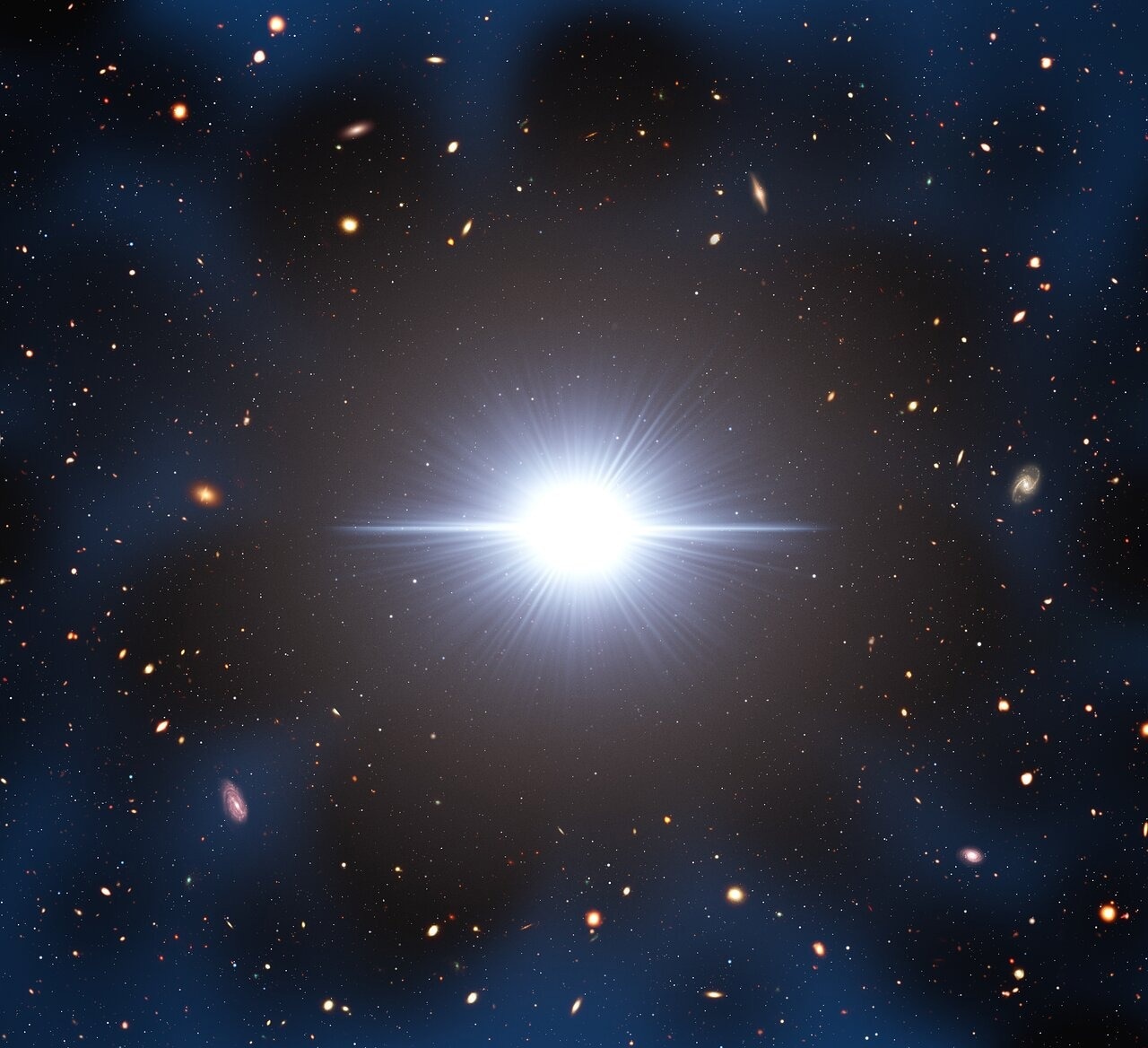Reviewed by Danielle Ellis, B.Sc.Sep 24 2024
Astronomers used the Dark Energy Camera (DECam) to confirm that early-Universe quasars form in densely populated regions of space, revealing why previous studies yielded conflicting results. The findings, published in the journal Astronomy & Astrophysics, highlight the need for wide-area searches to study quasar environments accurately and offer a potential explanation for the discrepancies in earlier observations.
 Artist Illustration of Early-Universe Quasar Cosmic Neighborhood. Observations using the Department of Energy-fabricated Dark Energy Camera (DECam) on the US National Science Foundation Víctor M. Blanco 4-meter Telescope confirm astronomers’ expectation that early-Universe quasars formed in regions of space densely populated with smaller companion galaxies. DECam’s exceptionally wide field of view and special filters played a crucial role in reaching this conclusion, and the observations reveal why previous studies seeking to characterize the density of early-Universe quasar neighborhoods have yielded conflicting results. Image Credit: NOIRLab/NSF/AURA/M. Garlick/J. da Silva (Spaceengine)/M. Zamani
Artist Illustration of Early-Universe Quasar Cosmic Neighborhood. Observations using the Department of Energy-fabricated Dark Energy Camera (DECam) on the US National Science Foundation Víctor M. Blanco 4-meter Telescope confirm astronomers’ expectation that early-Universe quasars formed in regions of space densely populated with smaller companion galaxies. DECam’s exceptionally wide field of view and special filters played a crucial role in reaching this conclusion, and the observations reveal why previous studies seeking to characterize the density of early-Universe quasar neighborhoods have yielded conflicting results. Image Credit: NOIRLab/NSF/AURA/M. Garlick/J. da Silva (Spaceengine)/M. Zamani
Material accreting onto supermassive black holes at the centers of galaxies powers quasars, the most brilliant objects in the universe. The majority of astronomers believe that early Universe quasars formed in some of the densest environments in the Universe, where gas was most abundant because studies have shown that these quasars have black holes so massive that they must have been consuming gas at very high rates.
The inconsistent results have been obtained from observational measurements aimed at verifying this conclusion.
The Department of Energy manufactured DECam, which is installed on the Víctor M. Blanco 4-meter Telescope of the National Science Foundation at Cerro Tololo Inter-American Observatory in Chile. This observatory is part of NSF NOIRLab.
Trystan Lambert led the study. Lambert completed the work as a Ph.D. student at the Institute of Astrophysical Studies at Diego Portales University in Chile and is currently a postdoc at the International Centre for Radio Astronomy Research (ICRAR) node at the University of Western Australia.
The team required a quasar with a well-defined distance to conduct their investigation. Fortunately, the Atacama Large Millimeter/submillimeter Array (ALMA) observations of quasar VIK 2348–3054 have yielded a known distance, and DECam's three-square-degree field of view offered a comprehensive view of its cosmic neighborhood. By coincidence, DECam also has a narrowband filter that is ideal for finding its companion galaxies.
This quasar study really was the perfect storm. We had a quasar with a well-known distance, and DECam on the Blanco telescope offered the massive field of view and exact filter that we needed.
Trystan Lambert, Ph.D. Student, Institute of Astrophysical Studies, Diego Portales University
The team counted the number of companion galaxies surrounding the quasar by detecting Lyman-alpha radiation, a very specific type of light that these galaxies emit, thanks to DECam's specialized filter. During star formation, hydrogen undergoes ionization and subsequent recombination that produces a unique energy signature known as Lyman alpha radiation.
The Lyman-alpha emission from Lyman-alpha emitters, which are mainly younger, smaller galaxies, can be used to accurately determine how far apart they are. Using the distance measurements for several Lyman-alpha emitters, a three-dimensional map of a quasar's neighborhood can then be created.
Following a methodical mapping of the space surrounding quasar VIK J2348-3054, Lambert and colleagues discovered 38 companion galaxies in the quasar's wider vicinity, extending up to 60 million light-years away. This research aligns with the expectations of quasars that inhabit dense regions. They discovered that there were none at all within 15 million light-years of the quasar.
This result sheds light on the validity of previous attempts to categorize early-Universe quasar environments and suggests a potential reason for their inconsistent outcomes. Since no other survey of this type has used a search area as large as the one DECam provides, the environment around a quasar may appear deceptively empty to smaller-area searches.
DECam’s extremely wide view is necessary for studying quasar neighborhoods thoroughly. You really have to open up to a larger area. This suggests a reasonable explanation as to why previous observations are in conflict with one another.
Trystan Lambert, Ph.D. Student, Institute of Astrophysical Studies, Diego Portales University
The group also explains why there are no companion galaxies in the quasar's immediate neighborhood. The group postulates that the intensity of the radiation from the quasar may be large enough to affect or potentially stop the formation of stars in these galaxies, making them invisible to our observations.
“Some quasars are not quiet neighbors. Stars in galaxies form from gas that is cold enough to collapse under its gravity. Luminous quasars can potentially be so bright as to illuminate this gas in nearby galaxies and heat it, preventing this collapse,” said Lambert.
Currently, Lambert's group is making more observations to confirm the suppression of star formation and obtain spectra. To create a more reliable sample size, the group also intends to observe additional quasars.
These findings show the value of the National Science Foundation’s productive partnership with the Department of Energy.We expect that productivity will be amplified enormously with the upcoming NSF–DOE Vera C. Rubin Observatory, a next-generation facility that will reveal even more about the early Universe and these remarkable objects.
Chris Davis, Program Director, NSF NOIRLab
Journal Reference:
Lambert, S, T., et al. (2024) A lack of Lyman alpha emitters within 5Mpc of a luminous quasar in an overdensity at z=6.9: Potential evidence of negative quasar feedback at protocluster scales. Astronomy and Astrophysics. doi.org/10.1051/0004-6361/202449566